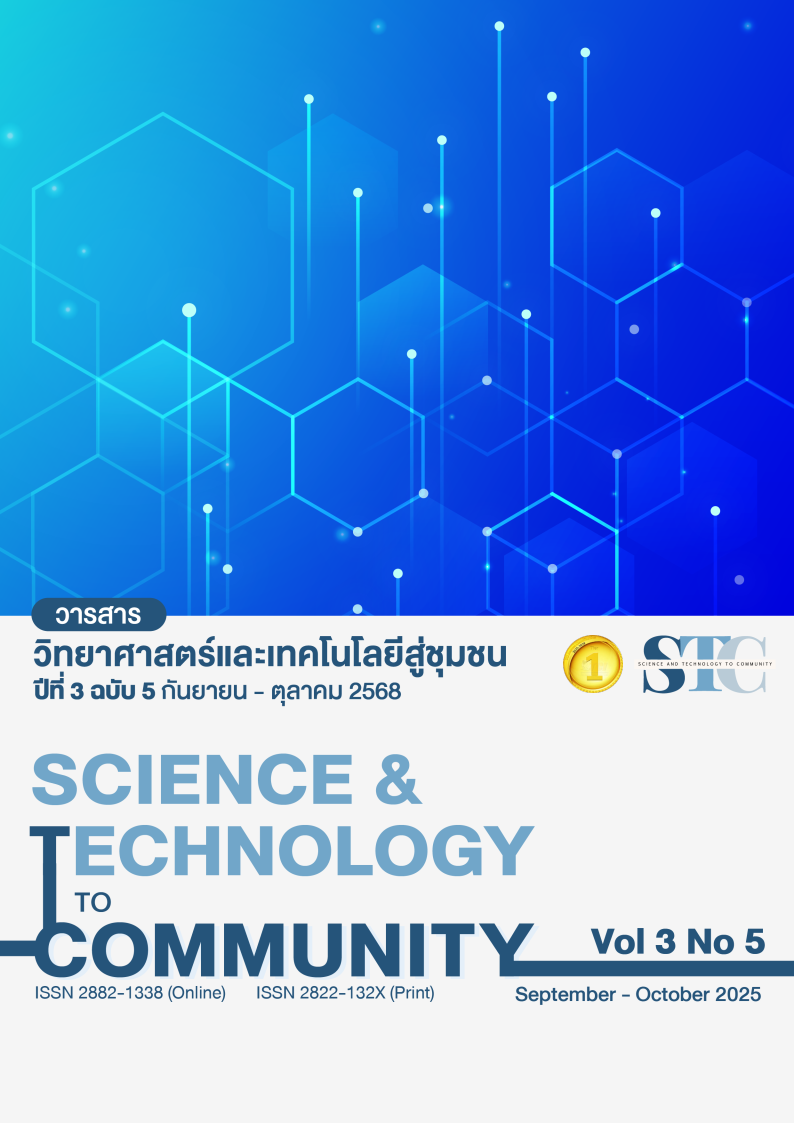การประมาณค่าพารามิเตอร์เหมาะที่สุดในวิธีโฮลต์-วินเทอร์และการแยกส่วนประกอบด้วยอัลกอริทึมการค้นหาแบบนกกาเหว่า : การพยากรณ์ปริมาณน้ำไหลรายเดือนเข้าสู่อ่างเก็บน้ำของเขื่อนขนาดใหญ่ในภาคกลางและภาคตะวันตกของประเทศไทย
DOI:
https://doi.org/10.57260/stc.2025.1089คำสำคัญ:
อนุกรมเวลา, การพยากรณ์, อ่างเก็บน้ำเขื่อน, ค้นหาค่าเหมาะที่สุดแบบนกกาเหว่าบทคัดย่อ
การศึกษานี้มีจุดมุ่งหมายเพื่อประเมินประสิทธิภาพของตัวแบบ ซึ่งผสานอัลกอริทึม การค้นหาแบบนกกาเหว่า (Cuckoo search: CS) เข้ากับวิธีโฮลต์-วินเทอร์ (CS-HW) และวิธีการแยกส่วนประกอบ (CS-D) สำหรับการพยากรณ์ปริมาณน้ำไหลรายเดือนเข้าสู่อ่างเก็บน้ำของเขื่อนขนาดใหญ่ในภาคกลางและภาคตะวันตกของประเทศไทยจำนวน 5 แห่ง โดยเปรียบเทียบกับโปรแกรมสำเร็จรูป ได้แก่ โปรแกรม Minitab (Minitab-D) และโปรแกรม Excel (ForecastSheet-HW) ในระยะชุดข้อมูลฝึกฝน พบว่า CS-HW และ CS-D สามารถให้ค่าความคลาดเคลื่อนสัมบูรณ์เฉลี่ย (Mean absolute error: MAE) ต่ำกว่าวิธีโปรแกรมสำเร็จรูป แสดงถึงศักยภาพในการค้นหาค่าพารามิเตอร์ที่เหมาะสมยิ่งขึ้น
สำหรับระยะชุดข้อมูลทดสอบ ได้คัดเลือกตัวแบบสำหรับแต่ละอ่างเก็บน้ำ โดยใช้เกณฑ์ MAE ต่ำสุด ได้แก่ เขื่อนศรีนครินทร์ เลือก ForecastSheet-HW เขื่อนวชิราลงกรณ์ เขื่อนกระเสียว และเขื่อนทับเสลา เลือก CS-HW และเขื่อนป่าสักชลสิทธิ์ เลือก Minitab-D เมื่อใช้ตัวแบบที่ถูกคัดเลือกมาพยากรณ์ล่วงหน้า 24 เดือน พบว่า ปริมาณน้ำไหลเข้าอ่างเก็บน้ำเขื่อนทั้ง 5 แห่งมีลักษณะฤดูกาลชัดเจน โดยมีค่าสูงสุดในช่วงฤดูฝน (เดือนสิงหาคม–ตุลาคม) ผลการศึกษาชี้ให้เห็นว่าการผสานอัลกอริทึมเมตาฮิวริสติกส์อย่าง CS เข้ากับตัวแบบอนุกรมเวลาแบบดั้งเดิม สามารถช่วยเพิ่มความแม่นยำในการพยากรณ์ และเป็นประโยชน์ต่อการวางแผนบริหารจัดการทรัพยากรน้ำในอนาคต
Downloads
เอกสารอ้างอิง
กรมชลประทาน. (2568). ระบบฐานข้อมูลน้ำในอ่างเก็บน้ำ กรมชลประทาน. https://app.rid.go.th/reservoir/
วฐา มินเสน. (2567). เอกสารคำสอนการวิเคราะห์อนุกรมเวลา. คณะวิทยาศาสตร์ มหาวิทยาลัยเชียงใหม่.
Dorigo, M. (1992). Optimization, Learning and Natural Algorithms. Ph.D. thesis, Politecnico di Milano, Italy.
Dorigo, M., Birattari, M., & Stutzle, T. (2006). Ant colony optimization. IEEE Comput Intell, 1(4), 28–39. https://doi.org/10.1109/MCI.2006.329691
Gandomi, A. H., & Alavi, A. H. (2012). Krill herd: a new bio-inspired optimization algorithm. Communications in Nonlinear Science and Numerical Simulation, 17(12), 4831-4845. https://doi.org/10.1016/j.cnsns.2012.05.010
Geem, Z. W., Kim, J. H., & Loganathan, G. V. (2001). A new heuristic optimization algorithm: harmony search. Simulation, 76(2), 60-68. https://doi.org/10.1177/003754970107600201
Heidari, A. A., Mirjalili, S., Faris, H., Aljarah, I., Mafarja, M., & Chen, H. (2019). Harris hawks optimization: Algorithm and applications. Future Generation Computer Systems, 97, 849-872. https://doi.org/10.1016/j.future.2019.02.028
Jiang, W., Wu, X., Gong, Y., Yu, W., & Zhong, X. (2020). Holt–Winters smoothing enhanced by fruit fly optimization algorithm to forecast monthly electricity consumption. Energy, 193, 116779. https://doi.org/10.1016/j.energy.2019.116779
Kaewpaengjuntra, S., Somhom, S., & Saenchan, L. (2010). Electricity consumption forecasting model using hybrid Holt-Winters exponential smoothing and artificial bee colony algorithm. Information Technology Journal, 6(1), 12-17. https://ph01.tci-thaijo.org/index.php/IT_Journal/article/view/73218
Karaboga, D. (2005). An Idea Based on Honey Bee Swarm for Numerical Optimization (Technical Report No. TR06). Erciyes University, Engineering Faculty, Computer Engineering Department. https://abc.erciyes.edu.tr/pub/tr06_2005.pdf
Kennedy, J., & Eberhart, R. (1995). Particle Swarm Optimization. In 1995 IEEE
International Conference on Neural Networks (ICNN’95) (pp. 1942–1948). IEEE. https://doi.org/10.1109/ICNN.1995.488968
Mauricio, C. C., & Ostia, C. F. (2023). Cuckoo search algorithm optimization of holt-winter method for distribution transformer load forecasting. In 9th International Conference on Control, Automation and Robotics (ICCAR) (pp. 36-42), Beijing, China. https://doi: 10.1109/ICCAR57134.2023.10151700
Minsan, W., & Minsan, P. (2023). Incorporating decomposition and the Holt-Winters method into the whale optimization algorithm for forecasting monthly government revenue in Thailand. Science & Technology Asia, 28(4), 38–53. https://ph02.tci-thaijo.org/index.php/SciTechAsia/article/view/250335
Minsan, P., & Minsan, W. (2024a). Decomposition and Holt-Winters techniques enhanced by whale optimization algorithm: case study of pm2.5 forecasting in 8 northern provinces of Thailand. Thai Science and Technology Journal, 32(6), 12-34. https://li01.tci-thaijo.org/index.php/tstj/article/view/261071
Minsan, W., & Minsan, P. (2024b). Decomposition and Holt-Winters enhanced by the whale optimization algorithm for forecasting the amount of water inflow into the large dam reservoirs in southern Thailand. Journal of Current Science and Technology, 14(2), article 38. https://doi.org/10.59796/jcst.V14N2.2024.38
Minsan, P., & Minsan, W. (2024c). Monthly volumes of water inflow into the large dam reservoirs in eastern Thailand forecasting by the cuckoo search optimization enhanced decomposition and Holt-Winters techniques. Thai Journal of Operations Research, 12(2), 69-89. https://ph02.tci-thaijo.org/index.php/TJOR/article/view/253542
Minsan, W., Minsan, P., & Panichkitkosolkul, W. (2024). Enhancing decomposition and Holt-Winters weekly forecasting of pm2.5 concentrations in Thailand’s eight northern provinces using the cuckoo search algorithm. Thailand Statistician, 22(4), 963–985. https://ph02.tci-thaijo.org/index.php/thaistat/article/view/256084
Minsan, P., & Minsan, W. (2025a). Forecasting rainfall in the Ping, Wang, Yom, and Nan River Basins of Thailand using decomposition and holt-winters methods enhanced by GRG nonlinear optimization. ASEAN J Sci Tech Report, 28(5), e259297. https://doi.org/10.55164/ajstr.v28i5.259297
Minsan, W., & Minsan, P. (2025b). GRG-HW and GRG-D optimization models for rainfall forecasting in the Yom river basin. figshare. Dataset. https://doi.org/10.6084/m9.figshare.28953389.v2
Mirjalili, S. (2016). Dragonfly algorithm: a new meta-heuristic optimization technique for solving single-objective, discrete, and multi-objective problems. Neural Computing and Applications, 27, 1053-1073. https://doi.org/10.1007/s00521-015-1920-1
Mirjalili, S., & Lewis, A. (2016). The whale optimization algorithm. Advances in Engineering Software, 95, 51-67. https://doi.org/10.1016/j.advengsoft.2016.01.008
Mirjalili, S., Mirjalili, S. M., & Lewis, A. (2014). Grey wolf optimizer. Advances in Engineering Software, 69, 46–61. https://doi.org/10.1016/j.advengsoft.2013.12.007
Pan, W. T. (2012). A new fruit fly optimization algorithm: taking the financial distress model as an example. Knowledge-Based Systems, 26, 69-74. https://doi.org/10.1016/j.knosys.2011.07.001
Vimolsutjarit, N., Minsan,W., Taninpong, P., & Thumronglaohapun, S. (2025). Forecasting Water Volume of Dam Reservoirs in Northern Thailand Using a Classical Decomposition and Holt-Winters Enhanced by Fruit Fly Optimization Algorithm. KKU Science Journal, 53(2), 205–218. https://ph01.tci-thaijo.org/index.php/KKUSciJ
Yang, X. S. (2009). Firefly Algorithms for Multimodal Optimization. In proceedings of 5th international symposium, SAGA 2009 Sapporo, Japan. https://doi.org/10.1007/978-3-642-04944-6_14
Yang, X. S. (2010). A New Metaheuristic Bat-Inspired Algorithm. In proceedings of nature inspired cooperative strategies for optimization (NICSO 2010). Berlin, Heidelberg: Springer Berlin Heidelberg. https://doi.org/10.1007/978-3-642-12538-6_6
Yang, X. S. (2012). Flower Pollination Algorithm for Global Optimization. In proceedings of unconventional computation and natural computation, Lecture notes in computer science. (pp. 240-249). https://doi.org/10.1007/978-3-642-32894-7_27
Yang, X. S., Deb, & S. (2009). Cuckoo Search Via Lévy Flights. In 2009 World Congress on Nature & Biologically Inspired Computing (NaBIC) (pp. 210–214). IEEE. https://doi.org/10.1109/NABIC.2009.5393690
ดาวน์โหลด
เผยแพร่แล้ว
รูปแบบการอ้างอิง
ฉบับ
ประเภทบทความ
สัญญาอนุญาต
ลิขสิทธิ์ (c) 2025 วารสารวิทยาศาสตร์และเทคโนโลยีสู่ชุมชน

อนุญาตภายใต้เงื่อนไข Creative Commons Attribution-NonCommercial-NoDerivatives 4.0 International License.
1. บทความ ข้อมูล เนื้อหา รูปภาพฯลฯ ที่ได้รับการตีพิมพ์ใน “วารสารวิทยาศาสตร์และเทคโนโลยีสู่ชุมชน” ถือเป็นลิขสิทธิ์ของวารสารวิทยาศาสตร์และเทคโนโลยีสู่ชุมชน มหาวิทยาลัยราชภัฏเชียงใหม่ หากบุคคลหรือหน่วยงานใดต้องการนำทั้งหมดหรือส่วนหนึ่งส่วนใดไปเผยแพร่ต่อหรือกระทำการใดๆ จะต้องได้รับอนุญาตเป็นลายลักษณ์อักษรจาก วารสารวิทยาศาสตร์และเทคโนโลยีสู่ชุมชน มหาวิทยาลัยราชภัฏเชียงใหม่
2. เนื้อหาบทความที่ปรากฏในวารสารเป็นความรับผิดชอบของผู้เขียนบทความโดยตรง ซึ่งกองบรรณาธิการวารสารไม่จำเป็นต้องเห็นด้วยหรือร่วมรับผิดชอบใดๆ














